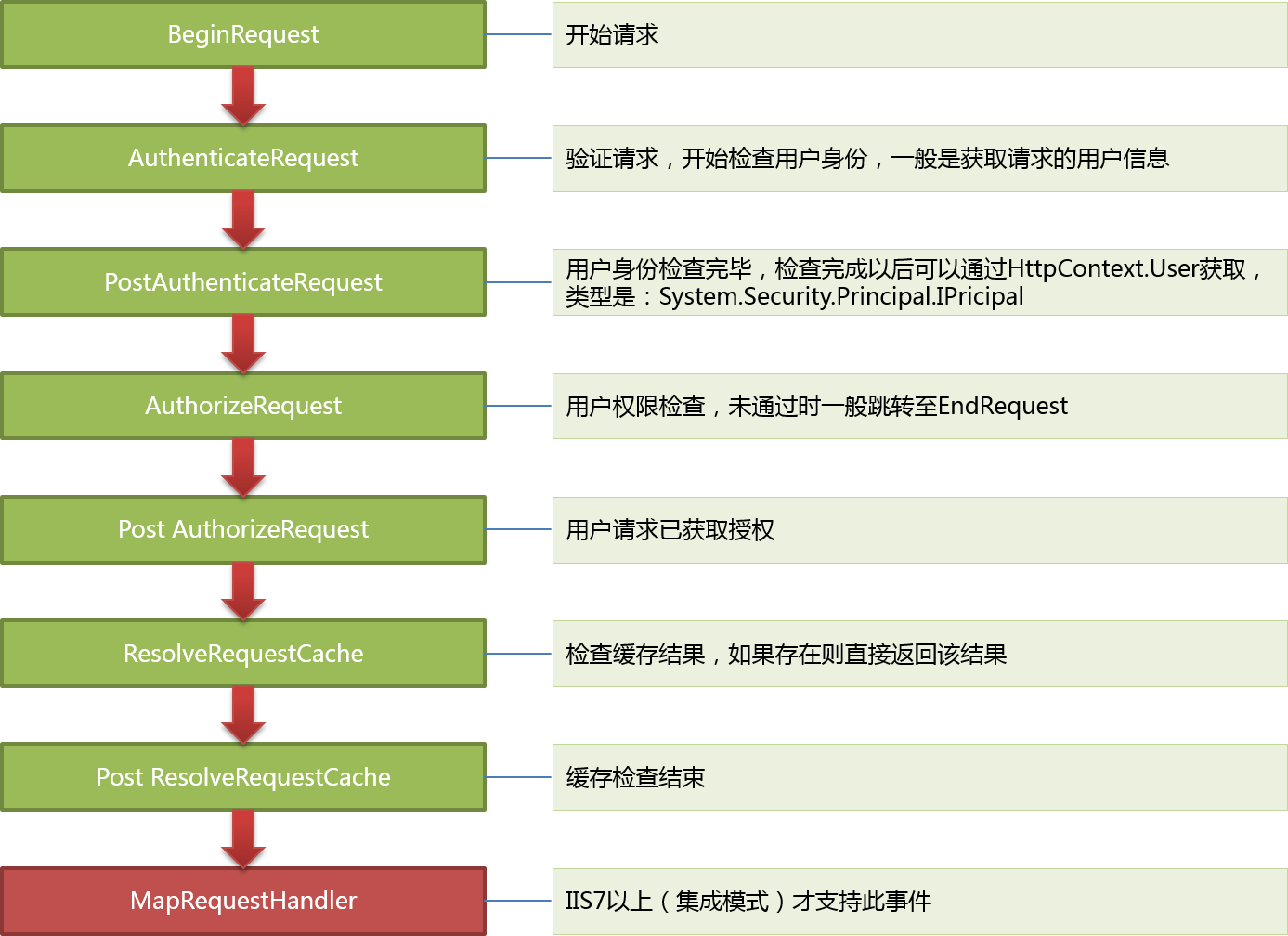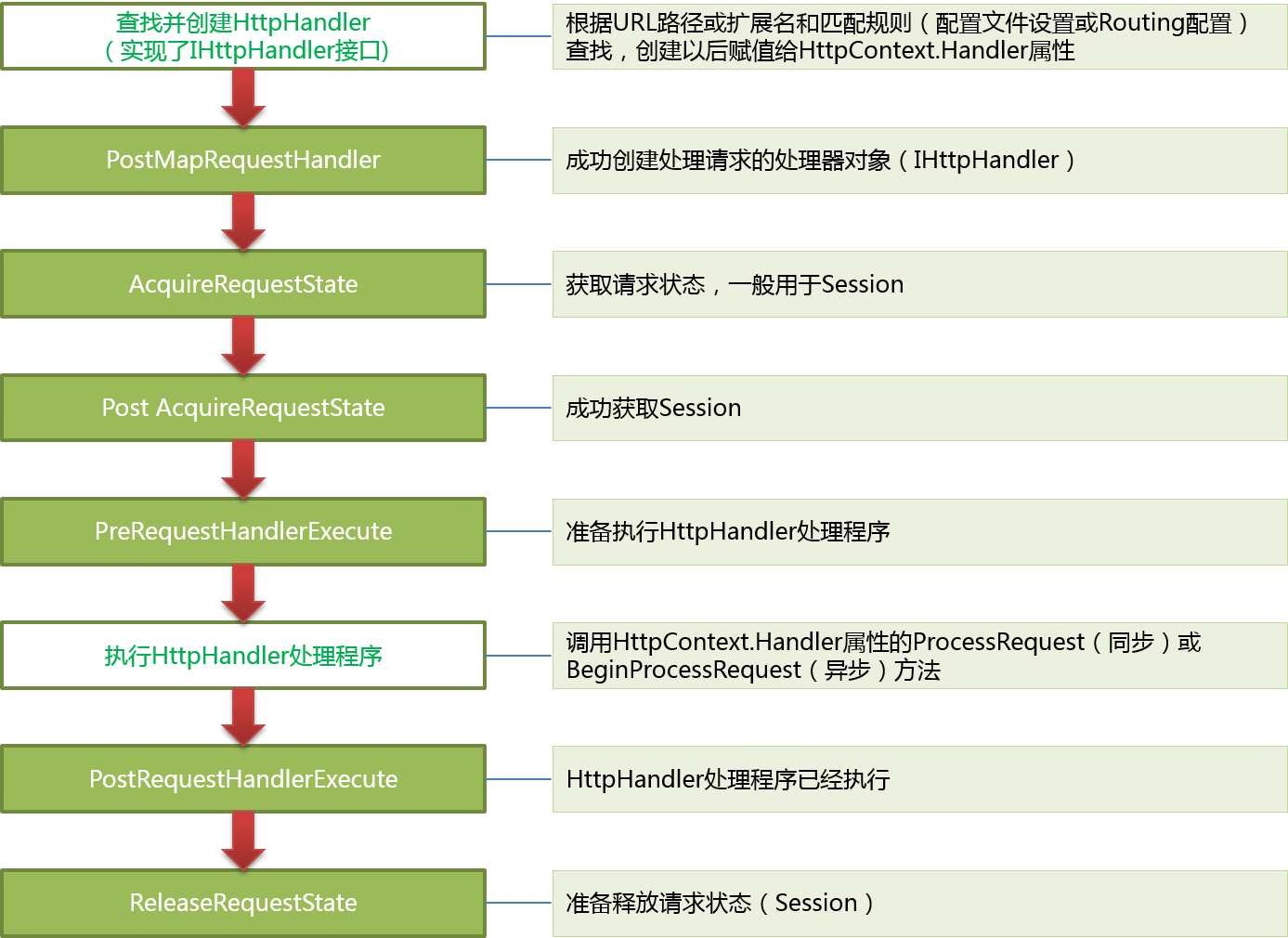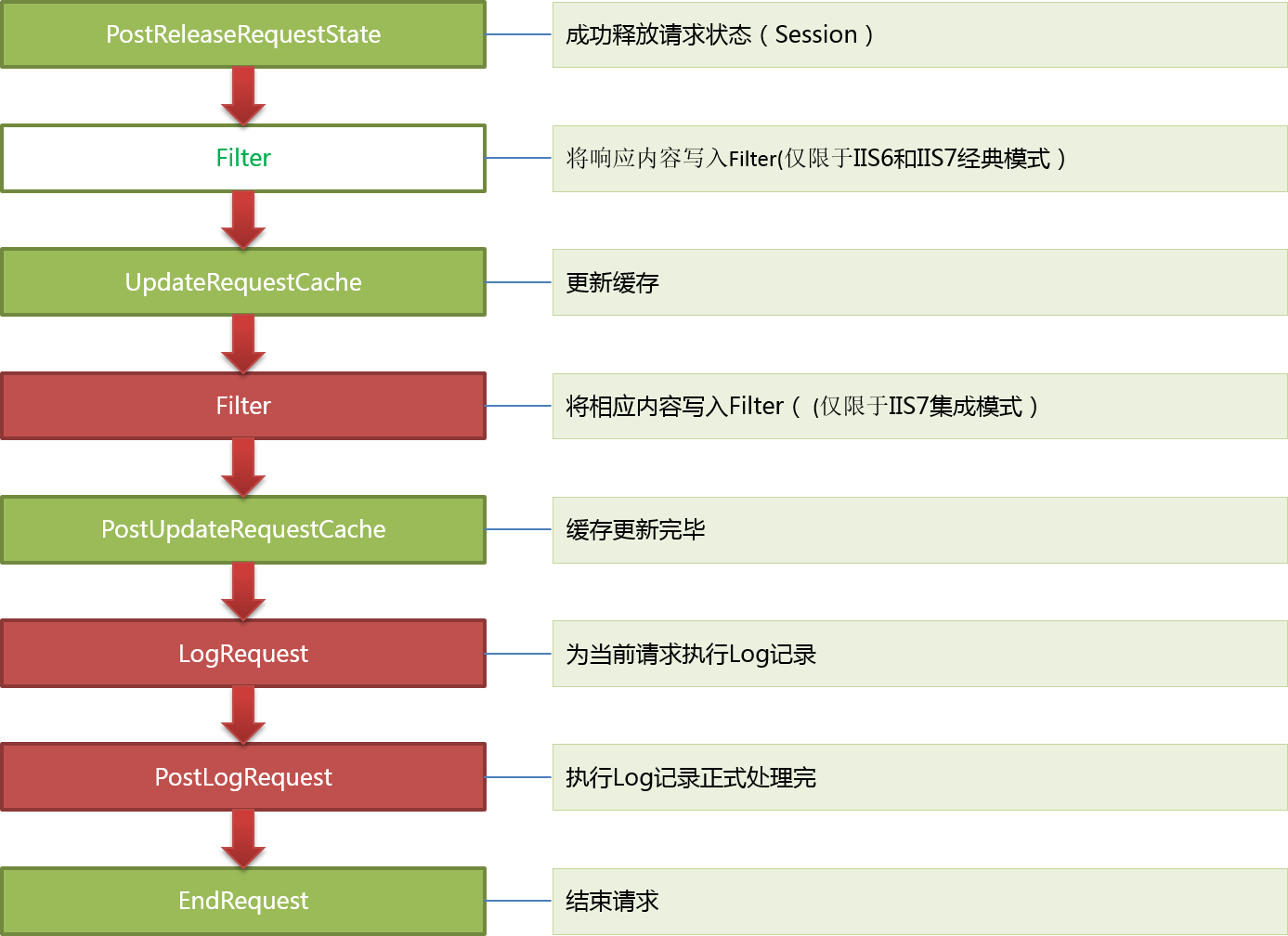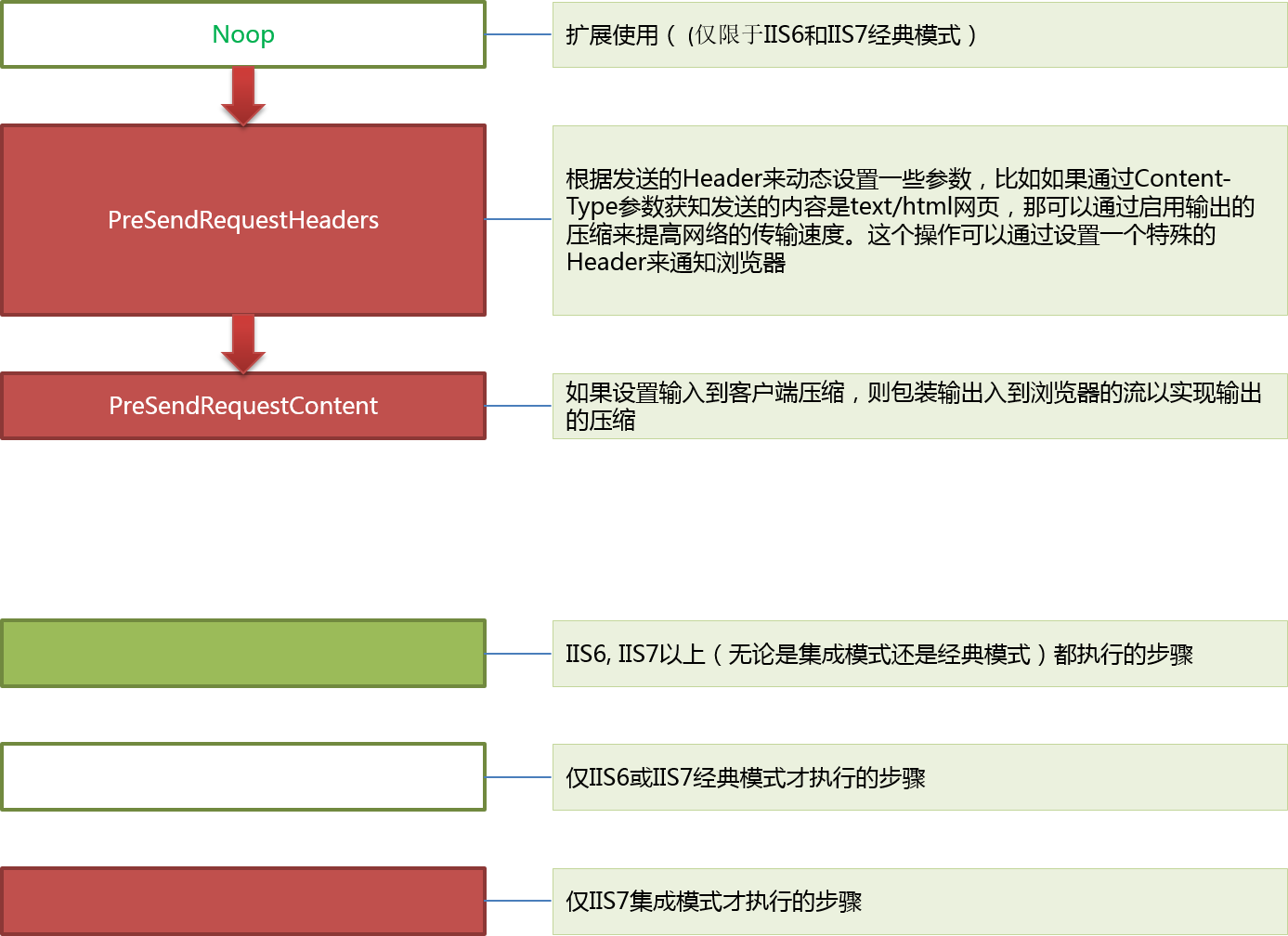MVC源码解析 - Http Pipeline 解析(下)
接上一篇, 我在 HttpModule 的Init方法中, 添加了自己的事件, 在Pipeline里, 就会把握注册的事件给执行了. 那么Pipeline是如何执行并且按照什么顺序执行的呢?
现在我们重新回到HttpApplication.InitInternal()方法中来. 注: Integrated 是集成的意思, 明白这个单词的意思之后, 下面这几句代码就很好理解了.
- if (HttpRuntime.UseIntegratedPipeline)
- {
- this._stepManager = new PipelineStepManager(this); //集成
- }
- else
- {
- this._stepManager = new ApplicationStepManager(this); //经典
- }
- this._stepManager.BuildSteps(this._resumeStepsWaitCallback);
集成模式和经典模式(或IIS6)使用的是不同的StepManager,这个类的BuildSteps方法就是为了创建有序的ExecutionStep,其中包括各种事件的事情以及其它在各时间周期之间穿插的操作,最主要的操作,大家以前就应该知道的,比如哪个周期可以判定使用哪个HttpHandler,以及在哪个周期内执行这个HttpHandler的BeginProcessRequest方法。
1. 经典模式
由于不同的StepManager处理方式不同,我们先看经典模式的处理代码:
- //HttpApplication的内部类ApplicationStepManager
- internal override void BuildSteps(WaitCallback stepCallback)
- {
- ArrayList steps = new ArrayList();
- HttpApplication app = base._application;
- bool flag = false;
- UrlMappingsSection urlMappings = RuntimeConfig.GetConfig().UrlMappings;
- flag = urlMappings.IsEnabled && (urlMappings.UrlMappings.Count > );
- steps.Add(new HttpApplication.ValidateRequestExecutionStep(app));
- steps.Add(new HttpApplication.ValidatePathExecutionStep(app));
- if (flag)
- {
- steps.Add(new HttpApplication.UrlMappingsExecutionStep(app)); //Url Mapping
- }
- app.CreateEventExecutionSteps(HttpApplication.EventBeginRequest, steps);
- app.CreateEventExecutionSteps(HttpApplication.EventAuthenticateRequest, steps);
- app.CreateEventExecutionSteps(HttpApplication.EventDefaultAuthentication, steps);
- app.CreateEventExecutionSteps(HttpApplication.EventPostAuthenticateRequest, steps);
- app.CreateEventExecutionSteps(HttpApplication.EventAuthorizeRequest, steps);
- app.CreateEventExecutionSteps(HttpApplication.EventPostAuthorizeRequest, steps);
- app.CreateEventExecutionSteps(HttpApplication.EventResolveRequestCache, steps);
- app.CreateEventExecutionSteps(HttpApplication.EventPostResolveRequestCache, steps);
- steps.Add(new HttpApplication.MapHandlerExecutionStep(app)); //Handle Mapping
- app.CreateEventExecutionSteps(HttpApplication.EventPostMapRequestHandler, steps);
- app.CreateEventExecutionSteps(HttpApplication.EventAcquireRequestState, steps);
- app.CreateEventExecutionSteps(HttpApplication.EventPostAcquireRequestState, steps);
- app.CreateEventExecutionSteps(HttpApplication.EventPreRequestHandlerExecute, steps);
- steps.Add(app.CreateImplicitAsyncPreloadExecutionStep());
- steps.Add(new HttpApplication.CallHandlerExecutionStep(app)); //execute handler
- app.CreateEventExecutionSteps(HttpApplication.EventPostRequestHandlerExecute, steps);
- app.CreateEventExecutionSteps(HttpApplication.EventReleaseRequestState, steps);
- app.CreateEventExecutionSteps(HttpApplication.EventPostReleaseRequestState, steps);
- steps.Add(new HttpApplication.CallFilterExecutionStep(app)); //Filtering
- app.CreateEventExecutionSteps(HttpApplication.EventUpdateRequestCache, steps);
- app.CreateEventExecutionSteps(HttpApplication.EventPostUpdateRequestCache, steps);
- this._endRequestStepIndex = steps.Count;
- app.CreateEventExecutionSteps(HttpApplication.EventEndRequest, steps);
- steps.Add(new HttpApplication.NoopExecutionStep());
- this._execSteps = new HttpApplication.IExecutionStep[steps.Count];
- steps.CopyTo(this._execSteps);
- this._resumeStepsWaitCallback = stepCallback;
- }
接着来看一下上面标红的那个方法:
- private void CreateEventExecutionSteps(object eventIndex, ArrayList steps)
- {
- AsyncAppEventHandler handler = this.AsyncEvents[eventIndex];
- if (handler != null)
- {
- handler.CreateExecutionSteps(this, steps);
- }
- EventHandler handler2 = (EventHandler) this.Events[eventIndex];
- if (handler2 != null)
- {
- Delegate[] invocationList = handler2.GetInvocationList();
- for (int i = ; i < invocationList.Length; i++)
- {
- steps.Add(new SyncEventExecutionStep(this, (EventHandler) invocationList[i]));
- }
- }
- }
- HttpApplication.EventBeginRequest 作为一个object的参数传入这个方法了, 并且从这个方法里面看, 它被当做了一个Key值来用. 那么他具体是个啥呢? 去HttpApplication中看一下.
- private static readonly object EventBeginRequest;
- static HttpApplication()
- {
- _dynamicModuleRegistry = new DynamicModuleRegistry();
- ......
- EventBeginRequest = new object();
- ......
- AutoCulture = "auto";
- _moduleIndexMap = new Hashtable();
- }
从这里能看到, 他真的就是一个object 类型的Key.
看着上面的代码是不是有似曾相识的感觉,很多讲声明周期的文章都会提到20多个的事件(BeginRequest, EndRequest等),我们来看看这个方法的完整功能都是做了什么,归纳总结有5点:
- 对请求的Request进行验证,ValidateRequestExecutionStep。
- 对请求的路径进行安全检查,禁止非法路径访问(ValidatePathExecutionStep)。
- 如果设置了UrlMappings, 进行RewritePath(UrlMappingsExecutionStep)。
- 执行事件处理函数,比如将BeginRequest、AuthenticateRequest转化成可执行ExecutionStep在正式调用时候执行。
- 在这18个事件操作处理期间,根据不同的时机加了4个特殊的ExecutionStep。
- MapHandlerExecutionStep:查找匹配的HttpHandler
- CallHandlerExecutionStep:执行HttpHandler的BeginProcessRequest
- CallFilterExecutionStep:调用Response.FilterOutput方法过滤输出
- NoopExecutionStep:空操作,留着以后扩展用
需要注意的是所有的ExecuteionStep都保存在ApplicationStepManager实例下的私有字段_execSteps里,而HttpApplication的BeginProcessRequest方法最终会通过该实例的ResumeSteps方法来执行这些操作(就是我们所说的那些事件以及4个特殊的Steps)。
2. 集成模式
好像在记忆里, 我发布的项目都是集成模式的. 那在这里来看一下集成模式是怎么执行的.
- //HttpApplication 的内部类 PipelineStepManager
- internal override void BuildSteps(WaitCallback stepCallback)
- {
- HttpApplication app = base._application;
//add special steps that don't currently
//correspond to a configured handler- HttpApplication.IExecutionStep step = new HttpApplication.MaterializeHandlerExecutionStep(app);
//implicit map step- app.AddEventMapping("ManagedPipelineHandler", RequestNotification.MapRequestHandler, false, step);
- app.AddEventMapping("ManagedPipelineHandler", RequestNotification.ExecuteRequestHandler, false,
app.CreateImplicitAsyncPreloadExecutionStep());
//implicit handler routing step- HttpApplication.IExecutionStep step2 = new HttpApplication.CallHandlerExecutionStep(app);
- app.AddEventMapping("ManagedPipelineHandler", RequestNotification.ExecuteRequestHandler, false, step2);
- HttpApplication.IExecutionStep step3 = new HttpApplication.TransitionToWebSocketsExecutionStep(app);
- app.AddEventMapping("ManagedPipelineHandler", RequestNotification.EndRequest, true, step3);
- HttpApplication.IExecutionStep step4 = new HttpApplication.CallFilterExecutionStep(app);
//normally, this executes during UpdateRequestCache as a high priority module- app.AddEventMapping("AspNetFilterModule", RequestNotification.UpdateRequestCache, false, step4);
//for error conditions, this executes during LogRequest as high priority module- app.AddEventMapping("AspNetFilterModule", RequestNotification.LogRequest, false, step4);
- this._resumeStepsWaitCallback = stepCallback;
- }
来看一下 RequestNotification.MapRequestHandler 是个什么东东.
- [Flags]
- public enum RequestNotification
- {
- AcquireRequestState = 0x20,
- AuthenticateRequest = ,
- AuthorizeRequest = ,
- BeginRequest = ,
- EndRequest = 0x800,
- ExecuteRequestHandler = 0x80,
- LogRequest = 0x400,
- MapRequestHandler = 0x10,
- PreExecuteRequestHandler = 0x40,
- ReleaseRequestState = 0x100,
- ResolveRequestCache = ,
- SendResponse = 0x20000000,
- UpdateRequestCache = 0x200
- }
从这里看, 他是一个枚举, 使用的时候, 肯定也是当做一个key值来用的. 但是为什么这里的枚举值少了许多呢?看这里的1,2,4之间, 好像少了3(PostAuthenticateRequest). 这是为啥呢?
没办法, 我只能直接去 HttpApplication 里面先看看这个事件.
- public event EventHandler PostAuthenticateRequest
- {
- add
- {
- this.AddSyncEventHookup(EventPostAuthenticateRequest, value, RequestNotification.AuthenticateRequest, true);
- }
- remove
- {
- this.RemoveSyncEventHookup(EventPostAuthenticateRequest, value, RequestNotification.AuthenticateRequest, true);
- }
- }
在这里发现, 他使用的是 RequestNotification.AuthenticateRequest, 那 AuthenticateRequest 事件呢, 用的是什么?
- public event EventHandler AuthenticateRequest
- {
- add
- {
- this.AddSyncEventHookup(EventAuthenticateRequest, value, RequestNotification.AuthenticateRequest);
- }
- remove
- {
- this.RemoveSyncEventHookup(EventAuthenticateRequest, value, RequestNotification.AuthenticateRequest);
- }
- }
他们使用的是同一个Key, 并且调用的是同一个方法 AddSyncEventHookup, 只是Post时, 多入了一个参数true
那么就看一下这个方法吧
- private void AddSyncEventHookup(object key, Delegate handler, RequestNotification notification, bool isPostNotification)
- {
- this.ThrowIfEventBindingDisallowed();
- this.Events.AddHandler(key, handler);
- if (this.IsContainerInitalizationAllowed)
- {
- PipelineModuleStepContainer moduleContainer = this.GetModuleContainer(this.CurrentModuleCollectionKey);
- if (moduleContainer != null)
- {
- SyncEventExecutionStep step = new SyncEventExecutionStep(this, (EventHandler) handler);
- moduleContainer.AddEvent(notification, isPostNotification, step);
- }
- }
- }
接着往下看AddEvent方法.
- internal void AddEvent(RequestNotification notification, bool isPostEvent, HttpApplication.IExecutionStep step)
- {
- int index = EventToIndex(notification);
- List<HttpApplication.IExecutionStep>[] listArray = null;
- if (isPostEvent)
- {
- if (this._modulePostSteps == null)
- {
- this._modulePostSteps = new List<HttpApplication.IExecutionStep>[0x20];
- }
- listArray = this._modulePostSteps;
- }
- else
- {
- if (this._moduleSteps == null)
- {
- this._moduleSteps = new List<HttpApplication.IExecutionStep>[0x20];
- }
- listArray = this._moduleSteps;
- }
- List<HttpApplication.IExecutionStep> list = listArray[index];
- if (list == null)
- {
- list = new List<HttpApplication.IExecutionStep>();
- listArray[index] = list;
- }
- list.Add(step);
- }
以这种方式, 节约了许多枚举值.
接着看 AddEventMapping 方法:
- private void AddEventMapping(string moduleName, RequestNotification requestNotification, bool isPostNotification, IExecutionStep step)
- {
- this.ThrowIfEventBindingDisallowed();
- if (this.IsContainerInitalizationAllowed)
- {
- PipelineModuleStepContainer moduleContainer = this.GetModuleContainer(moduleName);
- if (moduleContainer != null)
- {
- moduleContainer.AddEvent(requestNotification, isPostNotification, step);
- }
- }
- }
从这里能看到, 事件被注册到 PipelineModuleStepContainer 类型的一个moduleContainer 容器中了.
以上代码有2个地方和经典模式不相同:
- IIS7集成模式没有使用MapHandlerExecutionStep来装载ExecutionStep(也就是查找对应的HttpHandler),而是通过MaterializeHandlerExecutionStep类来获得HttpHandler,方式不一样,但最终都是调用HttpApplication.GetFactory方法来获取的,只不过IIS7集成模式有一些特殊操作而已罢了。
- IIS7集成模式是通过HttpApplication的AddEventMapping方法来添加事件的,从而将事件再次加入到前面所说的ModuleContainers容器。
另外有个很有技巧的代码:上述4个Steps所加的周期都不是准确的周期,比如CallHandlerExecutionStep应该是加载RequestNotification的枚举值PreExecuteRequestHandler 和ExecuteRequestHandler之间,为什么呢?因为本身CallHandlerExecutionStep只是一个特殊的step而不暴露事件的,所以枚举里也没有,那怎么办?回头看看AddEventMapping方法的第一个参数,它代表的是HttpModule的名字,查看其中的代码得知,在执行所有事件的时候,会遍历所有HttpModuel名称集合然后先执行全部BeginRequest事件,再全部执行AuthenticateRequest事件,以此类推,那我们能不能来伪造一个HttpModule的名称作为参数传递给AddEventMapping方法呢,答案是肯定的,看上面的代码,发现有2个伪造的名称分别是常量字符串 "AspNetFilterModule" (HttpApplication.IMPLICIT_FILTER_MODULE)和 "ManagedPipelineHandler" (HttpApplication.IMPLICIT_HANDLER),而因为之前其它HttpModule里的各种事件都已经load完了,所以这2个伪造HttpModule的是放在集合的最后面,所以在执行ExecuteRequestHandler类别的事件的时候,最后一个事件肯定就是这个伪造HttpModule的事件,再加上伪造HttpModule里没有别的事件,所以它对应的ExecutionStep的执行效果其实和IIS6里CallHandlerExecutionStep的效果是一样的,就这样,通过一个很奇特的技巧达到同样的目的。
最后,我们来总结一下.
在IIS7经典模式下,是用 Event+事件名称做key将所有事件的保存在HttpApplication的Events属性对象里,然后在BuildSteps里统一按照顺序组装,中间加载4个特殊的ExecutionStep,最后在统一执行;
在IIS7集成模式下,是通过HttpModule名称+RequestNotification枚举值作为key将所有的事件保存在HttpApplication的ModuleContainers属性对象里,然后也在BuildSteps里通过伪造HttpModule名称加载那4个特殊的ExecutionStep,最后按照枚举类型的顺序,遍历所有的HttpModule按顺序来执行这些事件。读者可以自行编写一个自定义的HttpModuel来执行这些事件看看效果如何。
最后关于Pipeline完整的图如下:




最后,需要注意的是:HttpApplication不是HttpRuntime所创建,HttpRuntime只是向HttpApplicationFactory提出请求,要求返回一个HttpApplication对象。 HttpApplicationFactory在接收到请求后,会先检查是否有已经存在并空闲的对象,如果有就取出一个HttpApplication对象返回给HttpRuntime,如果没有的话,则要创建一个HttpApplication对象给HttpRunTime。
转载参考:
MVC源码解析 - Http Pipeline 解析(下)的更多相关文章
- jQuery 2.0.3 源码分析Sizzle引擎解析原理
jQuery 2.0.3 源码分析Sizzle引擎 - 解析原理 声明:本文为原创文章,如需转载,请注明来源并保留原文链接Aaron,谢谢! 先来回答博友的提问: 如何解析 div > p + ...
- MyBatis 源码分析 - 映射文件解析过程
1.简介 在上一篇文章中,我详细分析了 MyBatis 配置文件的解析过程.由于上一篇文章的篇幅比较大,加之映射文件解析过程也比较复杂的原因.所以我将映射文件解析过程的分析内容从上一篇文章中抽取出来, ...
- FFmpeg的HEVC解码器源码简单分析:解析器(Parser)部分
===================================================== HEVC源码分析文章列表: [解码 -libavcodec HEVC 解码器] FFmpeg ...
- springMVC源码分析--RequestParamMethodArgumentResolver参数解析器(三)
之前两篇博客springMVC源码分析--HandlerMethodArgumentResolver参数解析器(一)和springMVC源码解析--HandlerMethodArgumentResol ...
- MVC系列——MVC源码学习:打造自己的MVC框架(四:了解神奇的视图引擎)
前言:通过之前的三篇介绍,我们基本上完成了从请求发出到路由匹配.再到控制器的激活,再到Action的执行这些个过程.今天还是趁热打铁,将我们的View也来完善下,也让整个系列相对完整,博主不希望烂尾. ...
- MVC系列——MVC源码学习:打造自己的MVC框架(三:自定义路由规则)
前言:上篇介绍了下自己的MVC框架前两个版本,经过两天的整理,版本三基本已经完成,今天还是发出来供大家参考和学习.虽然微软的Routing功能已经非常强大,完全没有必要再“重复造轮子”了,但博主还是觉 ...
- MVC系列——MVC源码学习:打造自己的MVC框架(二:附源码)
前言:上篇介绍了下 MVC5 的核心原理,整篇文章比较偏理论,所以相对比较枯燥.今天就来根据上篇的理论一步一步进行实践,通过自己写的一个简易MVC框架逐步理解,相信通过这一篇的实践,你会对MVC有一个 ...
- MVC系列——MVC源码学习:打造自己的MVC框架(一:核心原理)
前言:最近一段时间在学习MVC源码,说实话,研读源码真是一个痛苦的过程,好多晦涩的语法搞得人晕晕乎乎.这两天算是理解了一小部分,这里先记录下来,也给需要的园友一个参考,奈何博主技术有限,如有理解不妥之 ...
- [转]MVC系列——MVC源码学习:打造自己的MVC框架(一:核心原理)
本文转自:http://www.cnblogs.com/landeanfen/p/5989092.html 阅读目录 一.MVC原理解析 1.MVC原理 二.HttpHandler 1.HttpHan ...
- ASP.NET MVC 源码分析(一)
ASP.NET MVC 源码分析(一) 直接上图: 我们先来看Core的设计: 从项目结构来看,asp.net.mvc.core有以下目录: ActionConstraints:action限制相关 ...
随机推荐
- Visual Studio 单元测试之二---顺序单元测试
原文:Visual Studio 单元测试之二---顺序单元测试 此文是上一篇博文:Visual Studio 单元测试之一---普通单元测试的后续篇章.如果读者对Visual Studio的单元测试 ...
- Mysql 使用CMD 登陆
1. 将mysql 的bin 目录加到 系统环境变量中: 这样的目的是为了可以直接在cmd中使用mysql命令,而不用先CD到mysql的bin目录中. 3. 连接目标数据库 . Syntax: ...
- .Net中批量更新或添加数据
方法一:使用SqlBulkCopy实现批量更新或添加数据. SqlBulkCopy类一般只能用来将数据批量插入打数据库中,如果数据表中设置了主键,出现重复数据的话会报错,如果没有设置主键,那么将会添加 ...
- oracle中sql语句的优化
oracle中sql语句的优化 一.执行顺序及优化细则 1.表名顺序优化 (1) 基础表放下面,当两表进行关联时数据量少的表的表名放右边表或视图: Student_info (30000条数据)D ...
- Javascript多线程引擎(三)
Javascript多线程引擎(三) 完成对ECMAScript-262 3rd规范的阅读后, 列出了如下的限制条件 1. 去除正则表达式( 语法识别先不编写) 2. 去除对Function Decl ...
- 详解SpringMVC请求的时候是如何找到正确的Controller
详解SpringMVC请求的时候是如何找到正确的Controller[附带源码分析] 目录 前言 源码分析 重要接口介绍 SpringMVC初始化的时候做了什么 HandlerExecutionCha ...
- 事件处理(Event Handlers) ng-click操作
事件处理(Event Handlers) ng-click操作 step 10 本文主要通过介绍ng-click方法来对angularjs中的事件处理方法做个了解. 1.切换目录 git checko ...
- 多线程中lock用法的经典实例
多线程中lock用法的经典实例 一.Lock定义 lock 关键字可以用来确保代码块完成运行,而不会被其他线程中断.它可以把一段代码定义为互斥段(critical section),互斥段在一 ...
- media Queries实现一个响应式的菜单
使用media Queries实现一个响应式的菜单 Media queries是CSS3引入的一个特性,使用它可以方便的实现各种响应式效果.在这个示例中我们将会使用media queries实现一 ...
- 程序媛也会画图 之 在ubuntu下用GIMP制作gif
动画是什么?就是几张图片很快的顺序播放嘛,今天就画画gif小图吧,以后在演示效果图的时候也用的上. 1.准备一个小图 就用小绿人好了 2.打开GIMP 3.新建一个图片打开 文件 ->新建输入 ...
